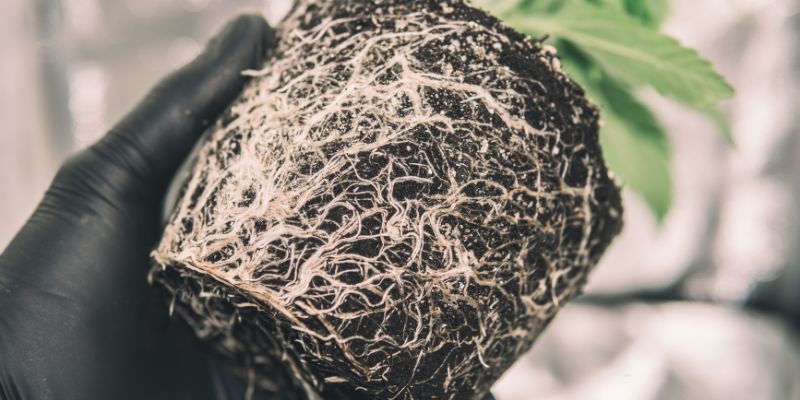Growing cannabis can be an incredibly rewarding experience, although gardeners must learn how to best address common challenges. One common issue growers face is dealing with root-bound plants. Root binding occurs when a plant outgrows its container, causing the roots to become tangled and compacted.
This can significantly impact the plant’s health and yield if not addressed promptly. It is very helpful for growers to know how to identify, prevent, and fix root-bound cannabis plants to promote healthy, thriving plants.
Understanding Root-Bound Cannabis Plants
A root-bound plant has roots that have filled the pot to the extent that they begin to circle and bind upon themselves. This condition restricts the plant’s ability to absorb water and nutrients, leading to stunted growth and other health issues.
Symptoms of Root-Bound Plants:
- Stunted Growth: The plant stops growing or grows very slowly.
- Yellowing Leaves: Older leaves turn yellow and fall off due to nutrient deficiencies.
- Wilting: The plant wilts easily, even with regular watering.
- Root Exposure: Roots may be visible above the soil or through drainage holes.
- Deformed Roots: When removed from the pot, the roots are densely packed and often form a thick mat around the edges.
Preventing Root-Bound Cannabis Plants
Prevention is always better than cure. Here are some strategies to prevent root binding:
1. Choose the Right Pot Size
Start with a pot that provides ample space for root growth. As the plant grows, consider transplanting it into a larger pot to accommodate the expanding root system. A good rule of thumb is to increase the pot size by about 2-3 gallons for each stage of growth.
2. Use Fabric Pots
Fabric pots, also known as Smart Pots, promote air pruning of roots. When roots reach the edge of the fabric pot, they are exposed to air, which naturally prunes them and encourages a more fibrous root system. This prevents roots from circling and becoming bound.
3. Regular Monitoring
Regularly check the growth and condition of your plants. Lift the pot occasionally to inspect the drainage holes for signs of roots growing out. Early detection allows for timely intervention.
Fixing Root-Bound Cannabis Plants
If you discover that your cannabis plant is root-bound, don’t worry. There are steps you can take to remedy the situation and get your plant’s health back on track.
1. Gently Remove the Plant from the Pot
To begin, carefully remove the plant from its current pot. If the roots are particularly dense, you might need to loosen the soil around the edges with a knife or a trowel. Be gentle to avoid causing unnecessary stress to the plant.
2. Inspect and Trim the Roots
Once the plant is out of the pot, inspect the root ball. If the roots are circling around the edges, use clean, sharp scissors to trim them back. This encourages new growth and helps the plant establish a healthier root system. Remove any dead or brown roots, as these are no longer contributing to the plant’s health.
3. Loosen the Root Ball
Gently loosen the root ball with your fingers. This helps the roots spread out in their new pot. Be careful not to damage the roots while doing this.
4. Transplant into a Larger Pot
Choose a pot that is significantly larger than the previous one. Fill it with high-quality potting soil, making sure to create a hole large enough to accommodate the root ball. Place the plant in the hole, spread the roots out, and fill in with soil around the roots. Ensure the plant is at the same soil level as it was in the previous pot.
5. Water Thoroughly
After transplanting, water the plant thoroughly to help the soil settle around the roots. This also helps to eliminate any air pockets that might have formed during the transplant process. Adding a root stimulator or a mild nutrient solution can also aid in reducing transplant shock and encouraging new root growth.
6. Monitor the Plant
Keep a close eye on the plant for the next few weeks. Ensure it receives adequate light, water, and nutrients. The plant may experience some initial stress, but with proper care, it should recover and continue to grow vigorously.
Additional Tips for Healthy Root Systems
Here are a few other tips you can follow to help promote a healthy root system:
Regular Pot Upgrades
If you’re growing in containers, plan regular pot upgrades throughout the plant’s life cycle. This ensures that the roots always have enough space to grow and prevents them from becoming root-bound.
Proper Watering Techniques
Overwatering can lead to compacted soil, which can contribute to root binding. Ensure proper watering techniques, allowing the soil to dry out slightly between watering sessions. This encourages the roots to grow deeper in search of water.
Soil Aeration
Adding perlite or vermiculite to your soil mix can improve aeration and drainage, preventing the soil from becoming too compacted and promoting healthy root growth.
Root Pruning
For advanced growers, root pruning can be an effective technique. By periodically pruning the roots, you can control the plant’s size and encourage a healthier root system. This technique requires experience and precision to avoid damaging the plant.
Root-bound cannabis plants can be a significant challenge, but with the right knowledge and techniques, you can prevent and fix this issue. Regular monitoring, choosing the right pot size, and using fabric pots can help keep your plants healthy.
If you do encounter root binding, gently removing the plant, trimming the roots, and transplanting it into a larger pot can rejuvenate your cannabis plant and get it back on track.
Mosca Seeds offers expert insights on cannabis cultivation, including how to prevent and fix root-bound cannabis plants. With the right care and attention, your cannabis plants can thrive and produce bountiful yields. Check out the Seed Bazaar for high-quality cannabis seeds to start your next successful grow. Happy growing!
